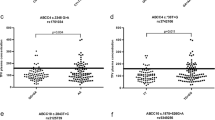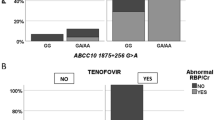Abstract
Tenofovir disoproxil fumarate (TDF) is a very effective antiviral drug that has been associated with tubular dysfunction. The aim of this study was to analyze the demographic, pharmacokinetic, and pharmacogenetic variables associated with TDF discontinuation for renal outcomes in stable HIV-positive patients using multivariable analyses. Three hundred and four patients were included (73% male, with median age and eCrCl of 45.3 years and 90.9 mL/min, respectively). After a median follow-up of 28.3 months, 27 patients discontinued TDF for renal adverse events [persistent urinary abnormalities (n = 21) or eCrCl < 60 mL/min (n = 6)] providing an incidence of 3.77 events per 100 patient-year. The probability of TDF discontinuation was higher with several features (male gender, older age, not Caucasians ancestry, absence of intravenous drug abuse, protease inhibitors, previous indinavir, HCV-positivity, lower CD4 cell count, detectable HIV-RNA, lower eCrCl, spot-urine proteinuria) and higher tenofovir concentrations but not genetic variants. Tenofovir plasma concentrations were prognostic of TDF discontinuation for renal adverse events suggesting that dose-adjustment may be warranted for long-term safety.
This is a preview of subscription content, access via your institution
Access options
Subscribe to this journal
Receive 6 print issues and online access
$259.00 per year
only $43.17 per issue
Buy this article
- Purchase on Springer Link
- Instant access to full article PDF
Prices may be subject to local taxes which are calculated during checkout


Similar content being viewed by others
References
Panel on Antiretroviral Guidelines for Adults and Adolescents. Department of Health and Human Services. Guidelines for the use of antiretroviral agents in HIV-1-infected adults and adolescents [Internet] [cited 20 Apr 2017]. http://aidsinfo.nih.gov/contentfiles/lvguidelines/AdultandAdolescentGL.pdf.
Ustianowski A, Arends JE. Tenofovir: what we have learnt after 7.5 million person-years of use. Infect Dis Ther. 2015;4:145–57.
Wang H, Lu X, Yang X, Xu N. The efficacy and safety of tenofovir alafenamide versus tenofovir disoproxil fumarate in antiretroviral regimens for HIV-1 therapy: meta-analysis. Medicine (Baltimore). 2016;95:e5146.
World Health Organization. Consolidated guidelines on HIV prevention, diagnosis, treatment and care for key populations 2016 update [Internet]. 2016 [cited 2017 Apr 20]. http://apps.who.int/iris/bitstream/10665/246200/1/9789241511124-eng.pdf?ua=1
Monteagudo-Chu MO, Chang MH, Fung HB, Bräu N. Renal toxicity of long-term therapy with tenofovir in HIV-infected patients. J Pharm Pract. 2012;25:552–9.
Scherzer R, Estrella M, Li Y, Choi AI, Deeks SG, Grunfeld C, et al. Association of tenofovir exposure with kidney disease risk in HIV infection. AIDS Lond Engl. 2012;26:867–75.
Jotwani V, Scherzer R, Estrella MM, Jacobson LP, Witt MD, Palella F, et al. Brief report: cumulative tenofovir disoproxil fumarate exposure is associated with biomarkers of tubular injury and fibrosis in HIV-infected men. J Acquir Immune Defic Syndr. 1999;73:177–81.
Tourret J, Deray G, Isnard-Bagnis C. Tenofovir effect on the kidneys of HIV-infected patients: a double-edged sword? J Am Soc Nephrol. 2013;24:1519–27.
Hall AM, Edwards SG, Lapsley M, Connolly JO, Chetty K, O’Farrell S, et al. Subclinical tubular injury in HIV-infected individuals on antiretroviral therapy: a cross-sectional analysis. Am J Kidney Dis. 2009;54:1034–42.
Calcagno A, Cusato J, Marinaro L, Simiele M, Lucchiari M, Alcantarini C, et al. Tenofovir clearance is reduced in HIV-positive patients with subclinical tubular impairment. AIDS Lond Engl. 2016;30:915–20.
Herlitz LC, Mohan S, Stokes MB, Radhakrishnan J, D’Agati VD, Markowitz GS. Tenofovir nephrotoxicity: acute tubular necrosis with distinctive clinical, pathological, and mitochondrial abnormalities. Kidney Int. 2010;78:1171–7.
Goicoechea M, Liu S, Best B, Sun S, Jain S, Kemper C, et al. Greater tenofovir-associated renal function decline with protease inhibitor-based versus nonnucleoside reverse-transcriptase inhibitor-based therapy. J Infect Dis. 2008;197:102–8.
Calcagno A, Gonzalez de Requena D, Simiele M, D’Avolio A, Tettoni MC, Salassa B, et al. Tenofovir plasma concentrations according to companion drugs: a cross-sectional study of HIV-positive patients with normal renal function. Antimicrob Agents Chemother. 2013;57:1840–3.
Moss DM, Neary M, Owen A. The role of drug transporters in the kidney: lessons from tenofovir. Front Pharmacol. 2014;5:248.
Pushpakom SP, Liptrott NJ, Rodríguez-Nóvoa S, Labarga P, Soriano V, Albalater M, et al. Genetic variants of ABCC10, a novel tenofovir transporter, are associated with kidney tubular dysfunction. J Infect Dis. 2011;204:145–53.
Calcagno A, Cusato J, Marinaro L, Trentini L, Alcantarini C, Mussa M, et al. Clinical pharmacology of tenofovir clearance: a pharmacokinetic/pharmacogenetic study on plasma and urines. Pharmacogenomics J. 2015;16:514–518.
Mocroft A, Lundgren JD, Ross M, Law M, Reiss P, Kirk O, et al. Development and validation of a risk score for chronic kidney disease in HIV infection using prospective cohort data from the D:A:D study. PLoS Med. 2015;12:e1001809.
van Buuren S, Groothuis-Oudshoorn K. Mice: multivariate imputation by chained equations in R. J Stat Softw. 2011;45:1–67.
Fine JP, Gray RJ. A proportional hazards model for the subdistribution of a competing risk. J Am Stat Assoc. 1999;94:496–509.
Kuk D, Varadhan R. Model selection in competing risks regression. Stat Med. 2013;32:3077–88.
Wolbers M, Blanche P, Koller MT, Witteman JCM, Gerds TA. Concordance for prognostic models with competing risks. Biostat Oxf Engl. 2014;15:526–39.
Mocroft A, Lundgren JD, Ross M, Fux CA, Reiss P, Moranne O, et al. Cumulative and current exposure to potentially nephrotoxic antiretrovirals and development of chronic kidney disease in HIV-positive individuals with a normal baseline estimated glomerular filtration rate: a prospective international cohort study. Lancet Hiv. 2016;3:e23–32.
Ezinga M, Wetzels JFM, Bosch MEW, van der Ven AJAM, Burger DM. Long-term treatment with tenofovir: prevalence of kidney tubular dysfunction and its association with tenofovir plasma concentration. Antivir Ther. 2014;19:765–71.
Lubomirov R, Colombo S, di Iulio J, Ledergerber B, Martinez R, Cavassini M, et al. Association of pharmacogenetic markers with premature discontinuation of first-line anti-HIV therapy: an observational cohort study. J Infect Dis. 2011;203:246–57.
Rungtivasuwan K, Avihingsanon A, Thammajaruk N, Mitruk S, Burger DM, Ruxrungtham K, et al. Influence of ABCC2 and ABCC4 polymorphisms on tenofovir plasma concentrations in Thai HIV-infected patients. Antimicrob Agents Chemother. 2015;59:3240–5.
Baxi SM, Greenblatt RM, Bacchetti P, Scherzer R, Minkoff H, Huang Y, et al. Common clinical conditions—age, low BMI, ritonavir use, mild renal impairment —affect tenofovir pharmacokinetics in a large cohort of HIV-infected women. AIDS Lond Engl. 2014;28:59–66.
Baxi SM, Scherzer R, Greenblatt RM, Minkoff H, Sharma A, Cohen M, et al. Higher tenofovir exposure is associated with longitudinal declines in kidney function in women living with HIV. AIDS Lond Engl. 2016;30:609–18.
Costarelli S, Cozzi-Lepri A, Lapadula G, Bonora S, Madeddu G, Maggiolo F, et al. Long-term durability of tenofovir-based antiretroviral therapy in relation to the co-Administration of other drug classes in routine clinical practice. PLoS ONE. 2016;11:e0160761.
Gagneux-Brunon A, Botelho-Nevers E, Frésard A, Lucht F. Preventing long-term tenofovir renal toxicity by pharmacokinetic assessment. AIDS Lond Engl. 2016;30:665–6.
Gervasoni C, Minisci D, Baldelli S, Mazzali C, Giacomelli A, Milazzo L, et al. Effect of cobicistat on tenofovir plasma concentration: a cross-sectional study. In: Abstract of the conference on retroviruses and opportunistic infections. Seattle, WA, USA, 2017.
Cattaneo D, Minisci D, Baldelli S, Mazzali C, Giacomelli A, Milazzo L, et al. Effect of cobicistat on tenofovir disoproxil fumarate (TDF): what is true for TAF may also be true for TDF. J Acquir Immune Defic Syndr. 1999;77:86–92.
Funding
The study was supported by internal funding. The previous study (the cross-sectional study) that originated this cohort was partially supported by a Gilead fellowship grant.
Author information
Authors and Affiliations
Corresponding author
Ethics declarations
Conflict of interest
AC has received honoraria from Abbvie, BMS, Gilead, Janssen-Cilag, MSD, Viiv and he is currently receiving research grants from BMS, Gilead, and Viiv. GDP and SB have received honoraria from Abbvie, BMS, Gilead, Janssen-Cilag, MSD, and Viiv. The remaining authors declare that they have no conflict of interest.
Electronic supplementary material
Rights and permissions
About this article
Cite this article
Calcagno, A., Fiumanò, M., Zugna, D. et al. Tenofovir disoproxil fumarate discontinuation for renal outcomes: any room for treatment personalization?. Pharmacogenomics J 19, 65–71 (2019). https://doi.org/10.1038/s41397-018-0064-y
Received:
Revised:
Accepted:
Published:
Issue Date:
DOI: https://doi.org/10.1038/s41397-018-0064-y
This article is cited by
-
Role of plasmatic and urinary concentration of tenofovir disoproxil fumarate in a cohort of patients affected by chronic hepatitis B
Archives of Virology (2022)
-
ABCC4 single-nucleotide polymorphisms as markers of tenofovir disoproxil fumarate-induced kidney impairment
The Pharmacogenomics Journal (2021)



